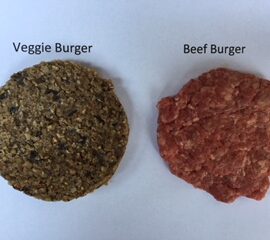Are veggie burgers nutritionally complete substitutes for beef burgers?
Do veggie burgers have a smaller ecological footprint than beef burgers?
Evidence suggests that diets high in red meat predict greater risk of adverse health outcomes including cardiovascular disease and mortality. Contrarily, high-quality omnivorous diets (including meat and lots of selected plant foods) do not show associations between red meat consumption and adverse health outcomes. The food industry has developed meat-free, plant-based alternatives to beef burgers. People who buy veggie burgers may be led to believe that these burgers contain all of the positive nutritional attributes of beef burgers and none of the negatives. Veggie burgers appear to be suitable substitutes for the sensory experience of eating meat. Nutrition Facts labels on these alternative products seem to show that veggie burgers are nutritionally equivalent to beef burgers. However, evidence reveals that veggie burgers are not nutritionally equivalent to the meat they replace.
In fact, plants contain a plethora of phytochemicals that appear in the meat and milk of animals, especially those that graze diverse pastures. Recent research shows that, compared to plant-based meat alternatives, meat (and milk) from grass-fed animals contains much higher concentrations of certain phytochemicals that possess anti-inflammatory, anti-tumor, and cardio-protective properties. Grazing animals, such as cattle, sheep, and goats, that feed on pastures with high plant species diversity show higher concentrations of phytochemicals in their meat and milk compared to animals grazed on plant monocultures or fed complete rations in feedlots. Plus, animals raised in diverse pastures exhibit better health than those raised on monocultures and/or finished in feedlots. The potential contribution of selected phytochemicals to promote human and animal health may be substantial but is largely ignored.
Researchers used a metabolomics approach to determine the extent to which a wide array of nutrients differed between meat and a meat-alternative. Eighteen samples of grass-fed ground beef and eighteen samples of a popular plant-based meatless alternative were cooked then analyzed using gas chromatography / mass spectrometry. Results showed markedly different concentrations of certain groups of nutrients (such as amino acids, saccharides, and phenols) in grass-fed ground beef and the plant-based alternative. Thus, ground beef and the meatless alternative are not nutritionally interchangeable. Rather, meat and plant-based foods may complement each other in terms of human nutrition.
The health and ecological impacts of meat production depend on numerous interacting factors. Calculations of the ecological footprint of vegetarian/vegan diets vs. omnivorous diets do not account for the reduced bioavailability of plant sources for certain nutrients, including protein, iron, and vitamin A. Veggie burgers may have a smaller ecological footprint than conventional (feedlot-finished) beef. On the other hand, well-managed, plant-diverse pastures can potentially fix in long-term soil storage the greenhouse gases that the meat animals produce. Substantial areas of land in the US and world-wide are not suitable for producing crops but are suitable for grazing animals. Well-managed grasslands, especially in moist environments, can serve as carbon sinks. The methane produced by belching cows and other ruminant animals is a highly potent greenhouse gas. Yet, methane has a short lifespan during which it’s converted to carbon dioxide, which has a far longer lifespan in the atmosphere. Methane from cattle is not likely to increase atmospheric CO2 in the US, especially in stable herds.
In his book Drawdown, Paul Hawken and colleagues identified regenerative practices, such as farmland restoration, conservation agriculture, and managed grazing, as collectively the number one way to sequester greenhouse gases arising from agriculture. On an individual farm basis, the integration of plant and animal production can improve soil health and increase crop yield. In a Japanese study, meat consumption made a minor contribution to the ecological footprint of diet. Confectionery intake, dining out, and alcohol made much greater contributions. We Americans would likely be better off nutritionally by shifting the standard American diet to one that emphasizes whole foods, including modest amounts of animal products from well-managed pasture operations.
The urbanization of the US and other parts of the globe separates humans from nature. We tend to view the Earth as a giant commodity to be exploited for utilitarian purposes, rather than as a community to revere. Researchers Provenza, Anderson, and Gregorini propose that we use nature as a model to produce and consume food. More specifically, reduce our dependence of fossil fuels and move beyond “either or” thinking with respect to plant- or animal-based eating. Can we feed, house, and otherwise care for the material and non-material requirements of life for nearly 8 billion people now (and billions more later) and avoid trashing our home in the process? The authors identify two possible paths. We continue to live based on scarcity, greed, and competition, while plundering the Earth’s resources and each other. Or we nurture our world and its human and other inhabitants from a foundation of love and respect.





